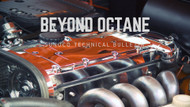Beyond Octane
By on Oct 17 2018
Overheard at the local track:
- “High octane fuels burn slower.”
- “My motor doesn’t need all that octane so that fuel won’t do me any good.”
- “I need the highest octane so I can max out my timing.”
Unfortunately, those statements are not always true. As a matter of fact, those statements only have some merit in the street gas world where 93 octane fuel is king and 87 is used by most. In the world of racing gasolines where higher octane choices abound, sharp engine builders and racers know they need to look beyond octane to find the right fuel.
But before we ignore octane, it’s important to look at how octane is measured in the first place.
Octane numbers are measured using single cylinder engines that look more like something out of a Model T than any modern engine. These so-called “knock” engines are operated by trained technicians in labs under controlled conditions. Two tests are used – one for Research Octane Number (RON) and another for Motor Octane Number (MON). The RON testresults in a higher octane value than theMON test.
If you average RON and MON, you get an octane value called AKI, short for Anti-Knock Index. It’s often labeled (R+M)/2, reflecting the fact that it is the average, or midpoint, between RON and MON. AKI is used to rate retail pump fuels, and it is the most commonly used octane value for race fuels as well.
For example – Sunoco Ultra 93 typically has a RON of 98 and a MON of 88, thus yielding an AKI of (98+88)/2 = 93. If you look closely at the yellow octane labels at gas stations, you’ll see the (R+M)/2 description under the big octane numbers. We provide all the octane numbers for all our race fuels – RON, MON, and AKI. So while we may refer to fuels like SR18 as “118 octane” (that’s the AKI value), we also show the RON and MON numbers under “Technical Details”. For SR18, that would be 120 and 116 for RON and MON, respectively.
Many times you’ll hear that MON is more important than RON because the MON test is performed under higher temperature and engine speed conditions. While this may be true, the laboratory test conditions are not indicative of what real race engines – heck, even mild street/strip motors for that matter – see at the track. Also, some engines have shown a better correlation between horsepower and RON. So, a word to the wise: don’t get hung up on octane numbers.
For a great example of why octane is not the only fuel parameter to ponder, consider the engines used in Formula 1. These engines have compression ratios exceeding 18:1 and spin at RPMs pushing 20,000. Sounds like a candidate for 116 octane race gas, right? Nope – they use a 96 octane fuel!
It’s hard to find a wider variety of race cars than what shows up at your local drag strip. On any given weekend you can see all sizes and shapes of engines ranging from raspy 4-cylinder motors to booming big blocks, and with all kinds of power adders thrown in the mix. This is where looking beyond octane becomes real important. What works for your buddy’s Pro Stock car may not be the best choice for your other buddy’s turbocharged import.
Naturally aspirated race motors with large combustion chambers spinning at high RPMs really like high-octane, fast burning fuels. They need the octane to prevent uncontrolled combustion, and they need a fast-burning fuel so that the flame front can span the large bore of the combustion chamber quickly. If you’re not sure which fuel burns faster than others, one indicator is specific gravity. “Lighter” fuels – fuels with a lower specific gravity – tend to burn faster because fast burning hydrocarbons are themselves light. Look for a specific gravity close to 0.70 and you’ll likely find a fast burning fuel. Of course, consult with the fuel producer to verify your assumptions. You might be surprised to learn that some of the highest octane fuels may also be some of the fastest burning fuels!
You might also be surprised to know that fast burning fuels may not need as much timing as their slower burning counterparts. Many times we get calls from individuals who are dialing in new motors on a fast burning fuel but they’re using timing and jetting numbers from their old motor and fuel combo. “Retard the timing a couple degrees and see what happens” is not the suggestion they expect to hear! With high octane, fast burning fuels, it is easy to dial in too much timing. In such cases, the engine is not detonating, but it is past the point of optimum spark advance, so it’s just heating things up and making less power. A little less timing may really wake up the motor.






